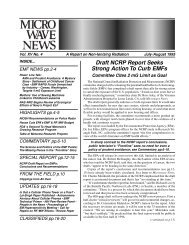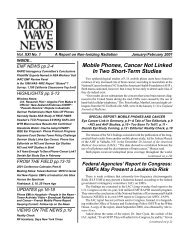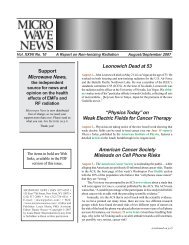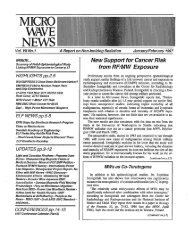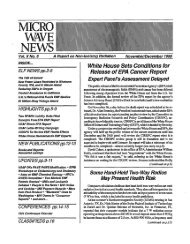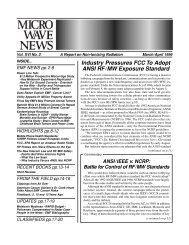Microwave News - November/December 1985
Microwave News - November/December 1985
Microwave News - November/December 1985
You also want an ePaper? Increase the reach of your titles
YUMPU automatically turns print PDFs into web optimized ePapers that Google loves.
GAO Blames Felec and Air<br />
Force for Clear Radar Accident<br />
The General Accounting Office (GAO) has concluded<br />
that Felec Services, Inc. PSI) and the Air Force were re-<br />
sponsible for the radiation accident at Clear Air Force Sta-<br />
tion in September 1983 in which six workers were overex-<br />
posed to rndiofrequeucy radiation.<br />
The GAO, a congressional investigatory bureau, found<br />
that any of several actions by either FSI or the Air Force<br />
could have prevented - or at least minimized - the acci-<br />
dent. "While the actions of one employee did initiate the<br />
accident," the GAO explains in its 65-page report, "this<br />
simple explanation does not consider the basic problems<br />
that allowed the accident to happen and to go undetected<br />
for eight minutes. In our opinion, the basic causes are var-<br />
ied, hut relate primarily to contractor noncompliance with<br />
operational and safety specifications in the contract and<br />
systemic problems in Air Force contract management prac-<br />
tices."<br />
The accident occurred at the Alaskan base on September<br />
14, 1983, when an FSI technician unknowingly switched<br />
on a transmitter that activated Clear's tracking radar, part<br />
of the U.S. Ballistic Missile Early Warning System, while<br />
eight workers were making repairs on and near the radar<br />
dish. The six workers on the dish were later found to have<br />
been exposed to levels in excess of safety standards - the<br />
highest exposure may have reached 390 mWlcm2 (see<br />
MWN, <strong>November</strong> 1983 and <strong>December</strong> 1984).<br />
Felec and DOD Responses<br />
FSI challenged the GAO's conclusions in comments it<br />
submitted on a review draft of the report, charging that the<br />
report "misrepresents the true facts of the case and the<br />
circumstances surmunding" the accident. The company<br />
argued that the operating procedures on the day of the ac-<br />
cident were in conformance with "Clear site instructions"<br />
and explained that the procedures had been modified to<br />
adapt to specific situations and conditions at Clear.<br />
The Department of Defense (WD) accepted the GAO's<br />
fmdings, however, and has agreed to make virtually all of<br />
the changes called for in the report. The earlier draft was<br />
also circulated to the Alaska Department of Labor, which<br />
suppad the GAO, and the U.S. Department of Labor,<br />
which did not respond. The final report is virtually un-<br />
changed from the draft.<br />
Democratic Alaska Congressman Don Young, who<br />
asked the GAO to investigate the accident, released the<br />
report on <strong>November</strong> 13. In a prepared statement, Young<br />
observed that, ',It is now up to the courts to review the<br />
circumstances of the accident to determine if compensation<br />
is dbe" to the exposed workers. Four of the workers have<br />
filed suits against FSI and RCA (see MWN, September1<br />
October <strong>1985</strong>), which was responsible for Clear for many<br />
years before FSI took over. (The Clear facility has been<br />
operated by the RCA Service Co., the ITT Arctic Services,<br />
Co., the RCA OMS Co. and FSI during its 23 years of<br />
operation. FSI, an ITT subsidiary, has had the operating<br />
coutract since 1975.)<br />
interlock Bypass<br />
According to the GAO, the accident would not have occurred<br />
if FSI had properly used the key interlock system<br />
that was designed to deactivate the radar system before<br />
workers entered the radome (radar housing). In fact, the<br />
GAO concluded that FSI routinely bypassed the system.<br />
Used properly, the interlock system would have made it<br />
virtually impossible to turn on the radar while anyone was<br />
in the radome.<br />
The GAO also found that FSI failed to correct ermrs in<br />
the configuration of the waveguides and in the wiring of<br />
the four transmitters used to power the tracking and three<br />
detection radars at Clear - a mistake which contributed<br />
directly to the accident. The system had been impmperly<br />
set up since its ~nstallation in 1961: contrary to the original<br />
design of the Clear facility, detection radar transmitters<br />
-<br />
were used to power the tracking radar.<br />
On the day of the accident, whiie performing a preventive<br />
maintenance routine, an FSI technician opened the<br />
waveguides to the inactive tracking radar - the interlock<br />
system would have prevented this, had it been used prop<br />
erly - and failed to close them before continuing his<br />
work. Soon afterward, the power to a detection radar was<br />
accidentally interrupted, deactivating the automatic transmitter<br />
selection function. When the technician manually<br />
switched the system back to its "normal" operating mode,<br />
power was mistakenly transfemed from the detection to the<br />
tracking radar, where the eight repairmen were working.<br />
The GAO criticized both FSI and the Air Force for their<br />
failure to correct the configuration problem: "...the accident<br />
would nut have happened if either the contractor or<br />
the Air Force had corrected the transmitter layout design as<br />
required by contract provisions and regulations governing<br />
technical orders. "<br />
The GAO also said that FSI had understaffed the facility<br />
and had permitted unqualified personnel to operate the<br />
radar on the day of the accident. The report notes that FSI<br />
had given a qualified worker the day off.<br />
FSI and the Air Force both issued reports soon after the<br />
accident, charging that the FSI technician's actions alone<br />
had caused the accident (see MWN, JanuaryIFebmary<br />
1984).<br />
Oversight and Enforcement<br />
The GAO found that the Air Force's Quality Assurance<br />
Evaluators (QAEs) responsible for contract compliance<br />
were not "technically trained in radar operation and main-<br />
tenance" and had no "prior training or experience in con-<br />
tract law and procurement procedures or general contract<br />
administration requirements." QAEs serve one-year terms,<br />
which do not permit them to become sufficientiy familiar<br />
with radar system contract compliance, the GAO charged.<br />
In addition, the Air Force failed to verify and validate<br />
technical orders before awarding the Clear contract to FSI,<br />
allowing the configuration ermrs to go uncorrected.<br />
The medical care given to the exposed workers was ade-<br />
MICRO WAVE NEWS Novembed<strong>December</strong> <strong>1985</strong>



